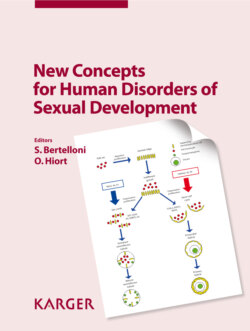Читать книгу New Concepts for Human Disorders of Sexual Development - Группа авторов - Страница 28
На сайте Литреса книга снята с продажи.
Peritubular Cells
ОглавлениеAlong the basal membrane of the seminiferous tubuli, peritubular cells (PTCs) are required for early histogenesis of the seminiferous cords. Together with the basal membrane and the Sertoli cells they form the blood-testis barrier and provide physical support for Sertoli cells. In the postpubertal testis, they may add contractile forces thought to be necessary for tubular fluid and sperm release. Via chemotactic signals from Sertoli cells, early PTCs and cells contributing to the vasculature of the testis migrate from the adjacent mesonephros [Cupp et al., 2003]. This migration process is an important step in sex determination and is SRY dependent. Normal SRY expression is related to GATA4, a gene expressed also by PTCs. GATA4 also activates steroidogenic genes such as StAR, CYP11A, CYP17, CYP19, and HSD3B2, which are mainly expressed in Leydig cells (online suppl. table 1). Considering this and the fact that they are highly proliferative cells, PTCs are demonstrating important features for normal testis development [Capel et al., 1999; Schmahl and Capel, 2003], but their precise role in adult testicular function is still not known. Data accumulated lately indicate their possible role as a reserve or stem cell pool [Haider et al., 1995] and that they might be involved in the regeneration of Leydig cells after a disruptive injury.
